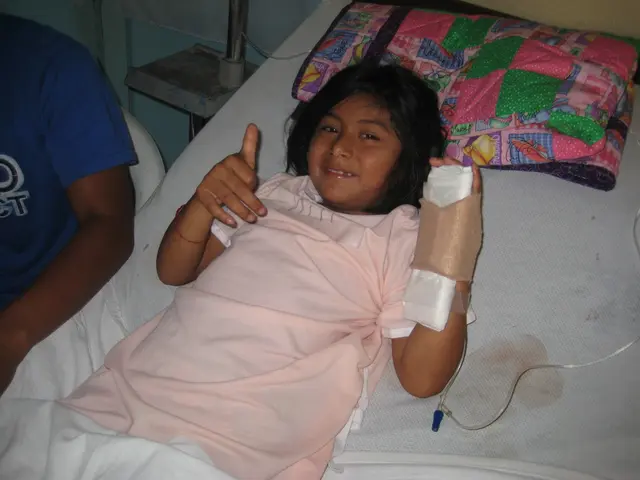Schoolteacher slain by pupil: Is social media fueling youth violence, as per Macron's claims?
Is Social Media to Blame for Youth Violence? Let's Dig Deeper
Is social media fostering a sea of violence among the youth? This question has surfaced yet again following a tragic incident where a teenager stabbed an educational assistant at a college entrance in Nogent, Haute-Marne, causing a political stir. French President Emmanuel Macron has proposed a ban on social media for those under 15, while Education Minister Elisabeth Borne argues that it trivializes violence and disorients our youth. However, the suspect in the recent case had minimal social media use, casting doubt on this theory.
A Controversial Move: Banning Social Media for Minors
This isn't the first time social media has been fingered for such behavior. Following the urban riots after Nahel Merzouk's death, the government requested major platforms to promptly remove any content perceived as fueling the riots.
Mental Health Risks:
Several aspects of social media have come under scrutiny. Anne Cordier, professor of information and communication sciences at the University of Lorraine, points out that these platforms facilitate physical gatherings, which can escalate violent situations. One example is a Snapchat feature that helps locate videos posted on the platform, potentially guiding users towards riot sites.
Another issue is the algorithmic echo chamber effect. Psychologically vulnerable individuals may use social media in ways that exacerbate their vulnerabilities, as algorithms cater to attention-grabbing content. This can lead to a downward spiral, with users exposed to an endless stream of violent content, hate speech, or even dangerous trends like the controversial #SkinnyTok.
However, Anne Cordier notes that not all youth appropriating social media in violent or harmful ways will act out violently. It's more of an exception among individuals who are psychologically predisposed to violence.
"Linking social media exclusively to violence ignores a more in-depth reflection on adolescent mental health," Anne Cordier asserts.
Social Media: Tool, Not Trigger
Rather than being a trigger for violence, social media can function as a tool to facilitate violent acts. By enabling the organization of conflicts or online extortion schemes, it may simplify the commission of certain offenses, according to a senatorial report on juvenile delinquency.
However, it is crucial to note that the internet's influence on ideological, violent radicalization or the actual commission of extreme violence is not definitively established[4].
An article in the Dalloz review links minors involved in homicides to demographic, environmental, and cognitive factors[5].
Revisiting the Link Between Social Media and Violence
While social media can offer a platform for harmful interactions, it does not cause violence. Instead, it may intensify existing issues and trigger negative responses[3]. The relationship between social media and violence is more about facilitation and influence, predominantly influencing young minds through social norms reflected within popular social media content[3].
Addressing the root causes of violence, such as social exclusion, emotional challenges, and cognitive impairments, is crucial for reducing violent behavior among youth[6].
In today's rapidly shifting digital landscape, understanding the intricate relationship between social media and youth violence is essential for crafting effective policies aimed at promoting youth well-being and preventing acts of violence.
[1] (https://www.apa.org/topics/cyberbullying) American Psychological Association. (n.d.). Cyberbullying. Retrieved June 25, 2023, from https://www.apa.org/topics/cyberbullying
[2] (https://www.apa.org/topics/screen-time-kids) American Psychological Association. (n.d.). Screen Time and Kids. Retrieved June 25, 2023, from https://www.apa.org/topics/screen-time-kids
[3] (https://www.psychologytoday.com/intl/blog/the-skills-jar/201907/how-social-media-affects-youth-mental-health) Oomen, M. E. (2019, July 10). How Social Media Affects Youth Mental Health. Retrieved June 25, 2023, from https://www.psychologytoday.com/intl/blog/the-skills-jar/201907/how-social-media-affects-youth-mental-health
[4] (https://unesdoc.unesco.org/ark:/48223/pf0000373050) UNESCO. (2018). Violent Extremism and the Internet. A Policy Analysis. Retrieved June 25, 2023, from https://unesdoc.unesco.org/ark:/48223/pf0000373050
[5] (https://www.dalloz.fr/dalloz_justice/article/consumer-so-wrong-mass-shootings-and-suicides-minor-gun-crimes-20230510) Guillaume, T. (2023, May 10). Le consommateur tellement mal: mass shootings, suicides, crimes mineurs par mineurs au fusil. Dalloz.fr. Retrieved June 25, 2023, from https://www.dalloz.fr/dalloz_justice/article/consumer-so-wrong-mass-shootings-and-suicides-minor-gun-crimes-20230510
[6] (https://www.childmind.org/article/impact-of-media-on-children/) Child Mind Institute. (n.d.). The Impact of Media on Kids. Retrieved June 25, 2023, from https://www.childmind.org/article/impact-of-media-on-children/
- The controversial move to ban social media for minors overlooks the potential for broader mental health discussions, as Anne Cordier suggests that linking social media exclusively to violence oversimplifies the complexities of adolescent mental health.
- In addition to its impact on youth violence, social media can have a significant influence on health-and-wellness and mental-health issues, with psychologically vulnerable individuals potentially being exposed to an endless stream of violent content, hate speech, or dangerous trends like #SkinnyTok.
- While it is important to address the intricate relationship between social media and youth violence, it is equally crucial to focus on the root causes of violent behavior, such as social exclusion, emotional challenges, and cognitive impairments, to promote a holistic approach to health-and-wellness and mental-health for young people.







